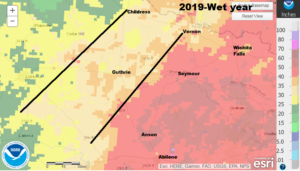Emi Kimura, Extension Agronomist, Vernon, TX
2018-2019 Cropping Season in Review
Rolling Plains wheat season started with very wet condition in September 2018 all the way to the end of October 2018. There were only a few days in October that producers were able to work in their fields due to the wet field conditions. Planting was delayed to November to December. Although field conditions during November to February were relatively dry across the Rolling Plains, precipitation received in March and April helped to increase yield potential. Rust pressures were lower than typical year and started in end of March to April when the rain event started. We observed a few freeze damages, but they were not major issues in 2019. Figure 1 describes total precipitation received during July 2018 to July 2019. It clearly divides the Rolling Plains into three precipitation ranges among 25-30 inch (yellow), 30-35 inch (beige), and 40-50 inch (red).
Figure 1. Precipitation during July 29, 2018 to July 29, 2019 in the Rolling Plains regions. Source: National Weather Service.
Pick’s List for 2019-2020 Growing Season in the Rolling Plains
Average grain yields among varieties and locations were 31 bu/ac in 2017, 35.2 bu/ac in 2018, and 47.1 bu/ac in 2019 in the Rolling Plains. Average yield of 2019 trials was the highest in the past 10 years.
The AgriLife Extension Wheat Pick’s list was selected based on the Rolling Plains Uniform Variety Trial (UVT) coordinated by the AgriLife Research and Extension personnel. Our ongoing Picks criteria include a minimum of three years of data in Texas A&M AgriLife Rolling Plains wheat variety trials across multiple locations. A “Pick” variety means this: given the data, these are the varieties we would choose to include and emphasize on our farm for wheat grain production. Picks are not necessarily the numerical top yielders as important disease resistance traits (leaf or stripe rust, wheat streak mosaic virus), insect tolerance (greenbugs, Russian wheat aphid), or standability can also be important varietal traits that enable a producer to better manage potential risk. We look for consistency of yields, e.g. the regularity with which an individual variety is in the top 25% of yield at each location.
Table 1. Pick’s list for 2019-2020 growing season for grain only use in the Rolling Plains of Texas
| Pick List (Leaf rust/Stripe rust) | Release | 3 years Avg. | 2019 Avg. | |
| bu/ac | bu/ac | |||
| 1 | WB 4269 (MS/MR) | Westbred | 41.5 | 47.0 |
| 2 | TAM 114 (MR/R) | Texas A&M | 40.8 | 50.4 |
| 3 | LCS Chrome (R/R) | Limagrain | 39.9 | 51.7 |
| 4 | SY Drifter (R/MR) | Syngenta | 39.3 | 48.8 |
| 5 | TAM 304 (MS/MR) | Texas A&M | 39.2 | 46.1 |
| 6 | Gallagher (S/R) | OSU/OGI | 37.8 | 49.4 |
| 7 | WB4721 (R/MR) | Westbred | 37.6 | 43.9 |
| 8 | SY Grit (S/R) | Syngenta | 37.4 | 40.1 |
Leaf rust/stripe rust resistance ratings: R, Resistant; MR, moderately resistant; MS, moderately susceptible; and S, susceptible.
Changes Made in Pick’s List for 2019-2020 Cropping Season
Varieties kept from 2018-2019 Pick’s list: TAM 114, TAM 304, Gallagher, SY Grit, and WB 4721. These varieties continued to perform excellent in the Rolling Plains in terms of grain yield and disease resistance.
Variety removed from 2018-2019 Pick’s list: Greer and WB Cedar. The 3 year average yield of Greer was below average, and WB cedar was not evaluated in the past two years.
Varieties added for 2018-2019 Pick’s list: SY Drifter, WB 4269, and LSC Chrome. Grain yield of these varieties were superior in the 3 year average (Table 1).
State-wide trial results are available at http://varietytesting.tamu.edu/wheat/.
Figure 2. Grey line represents average yields among varieties and locations, while orange line represents yield of Pick’s list variety.
Watch List for Dual-Purpose Varieties
Dual-purpose trials were conducted in Haskell, Wilbarger, and Foard County during 2018-2019 cropping season. There were 18 varieties entered into the dual-purpose trials, including OSU/OGI varieties (DoublestopCL+, GreenHammer, Smith’s Gold, Gallagher, Iba, Bentley, Showdown and a few experimental lines), TAMU varieties (TAM 304, TAM 401-awnless, TAM 204-awnless, TAM 114, and TAM 113), and Westbred varieties (WB4792, WB4303, WB4595, and WB4515). We were able to harvest both forage and grain yields only in Haskell County to evaluate the performance of varieties as a dual-purpose use; therefore, the watch list was created based on the trial results in Haskell County dual-purpose trial. Awnless varieties (TAM 401, TAM 204, and OSU Experimental lines) were not included in the data analysis due to major wild hog damages to the plots. Values were reported as % of test average, while the varieties were ranked in order of the highest % of test average.
Table 2. Watch list for dual-purpose use in the Rolling Plains of Texas for 2019-2020 growing season
| Watch List | Source | 2019 forage yields | 2019 grain yields | |
| % of test average | % of teast average | |||
| 1 | WB4595 | Westbred | 103% | 152% |
| 2 | WB4792 | Westbred | 119% | 117% |
| 3 | Green Hammer | Oklahoma | 106% | 109% |
| 4 | Smith’s Gold | Oklahoma | 132% | 88% |
| 5 | TAM 114 | Texas A&M | 118% | 94% |
| Test Average | 823 lb/ac | 28.8 bu/ac |
Grain yield of the dual-purpose trial is lower than wheat variety trials for grain use only because plots were clipped twice to simulate the grazing effect on grain yield. Among the 18 entries, WB 4595, WB 4792, and Green Hammer provided above average forage yields and grain yields. Although grain yields were lower than the test average, TAM 114 and Smith’s Gold provided high forage yield.
Forage and grain yields are available at https://agrilife.org/txrollingplainsagronomy/wheat-3/.

